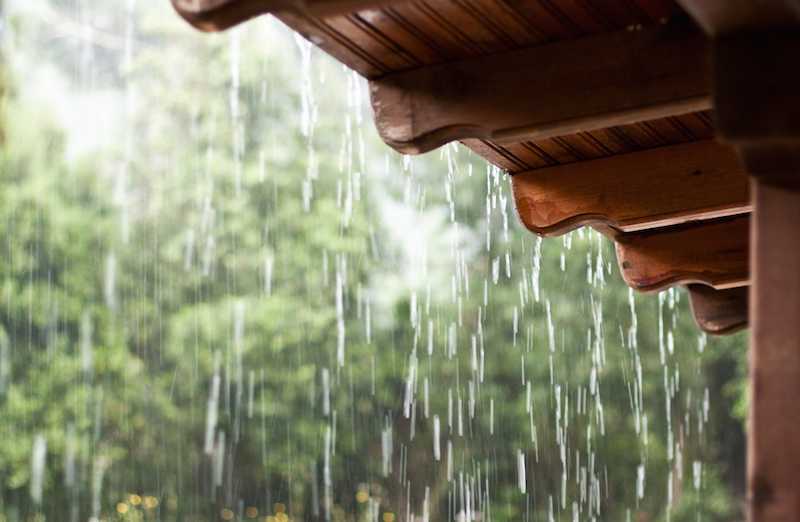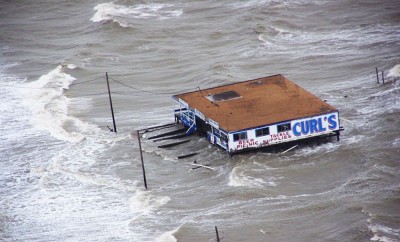Environment
Green roofs offer flood solutions and biodiversity

Image: Dushenina/Shutterstock
With the risk of flooding a persistent and growing concern for many cities, some engineers have developed an innovative green solution. The concept of green roofs is taking hold across the globe, with successful examples leading the way from Toronto to NYC, the UK to Portland, Paris, Denver, Roanoke, Seattle and Chicago, to name just a few. These living rooftops absorb excess rainwater before it can cause flooding or overwhelm sewer systems. All the while providing a uniquely beautiful and natural insulation for optimal temperatures and comfort.
While the concept of green roofing is not entirely new—first instances of anything similar were the Hanging Gardens of Babylon created near 500 B.C., with modernized versions being noted in Germany as early as the 1940’s—technological advances place them into a far better efficiency range than older examples. Modern green roofs are comprised of thin layers of vegetation and soil which, according to the University of California’s Institute of Environment and Sustainability Science Practicum Director Noah Garrison, “act like a sponge and will not release water until either over-saturated or the intensity of the rain is so hard that it can’t soak up fast enough.” Garrison adds that even when big storms hit, green roofs can at least slow the flow of water, meaning that, “A lot of runoff gets held to the roof, so you can kind of space out the peak flood time.”
Green roof concepts vary significantly throughout the cities in which they’re used, both in design and benefit. The environmental perks are expansive and undisputed, including the promotion of biodiversity, cooling of urban heat islands, and a contribution to the recommended increase of green space to combat climate change. Also, Kelly Ksiazek-Mikenas of Northwestern University has studied various types of vegetation used on green roofing, and finds many can utilize “different types of native grasses and wildflowers, which take up more water while providing a potential habitat for wildlife such as bees, butterflies and birds.”
In addition to flood control, rain water absorption and temperature control, other benefits include reduced energy use, reduced air pollution and greenhouse gas emissions, sound insulation, enhanced building amenity space, food growing potential, improved human health, comfort and quality of life, and enhanced water quality (since green roofs filter pollutants from rainfall). The cost of installing green roofing is lower than one might expect, as well. A recent University of Michigan study “compared the expected costs of conventional roofs with the cost of a 21,000-square-foot green roof and all its benefits, such as stormwater management and improved public health from the absorption of nitrogen oxides. The green roof would cost $464,000 to install versus $335,000 for a conventional roof in 2006 dollars. However, over its lifetime, the green roof would save about $200,000. Nearly two-thirds of these savings would come from reduced energy needs for the building with the green roof.” Some cities are also offering incentive programs to offset costs for those who might be interested in installing green roofing.
Many sites address concerns about the concept, including how to best design green roofing, and whether it could create more leakage or deterioration of building structures than conventional roofing. Evidence suggests green roofs are not more susceptible to leaks at all, and, in fact, are more likely to enhance the life cycle of a rooftop due to waterproof membranes protecting them from ultraviolet sunlight. According to one Forbes contributor, “A leaky roof is independent of whether it’s a green roof or a traditional roof. It has to do with the installation and design specification of the structure. All roofs must have a proper waterproofing membrane, green roofs included.” For the most part, the rule of thumb seems to be this: check with local architectural and engineering professionals for both design recommendations and plant selections for what is most likely to work best and thrive in your environment. Proper consideration to root barriers can stop plant roots from burrowing too deeply. For example, water-storing plants like sedum are a favorite for their attractiveness and heartiness on rooftops. Structural requirements will vary according to region and year-round weather conditions.
It appears the green rooftop offers solutions to many cities’ current environmental issues, and is also an attractive, energy-saving alternative for both homes and businesses. Several major cities like London, Chicago and Berkeley offer virtual maps to show citizens how green roofs are working for them and how they could implement something similar at home. Check your city’s green roof concepts out today!





0 comments